Mai 282012
- Serving of tea in China dates back to as early as the third century but it was in the 17th century A.D. that tea seeds were brought to Japan where they were grown in Buddhist temples and drank by monks for medicinal purposes. Green tea remained a rare and expensive commodity in Japan for centuries.
- In 1187, the monk Esai brought back from China tea seeds of a finer quality which he grew in Hakata ,Kyushu for a sect of Buddhism called Zen which was then becoming popular. The monk Esai is also credited with the grinding of tea leaves into matcha which the Chinese have used from 1053 A.D.
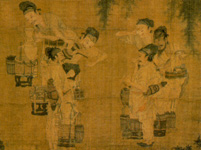
itinerant tea merchants (9/94)
- In the 1300s, the tosha , a game of tea-guessing, became quite popular. It involved serving 100 bowls of tea and the guests were expected to guess from which part of Japan each of the tea came from. This was replaced in the 1400s with cha-e which influenced the Shoin architectural style.
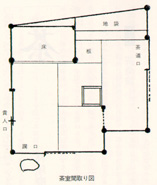 Tearoom blueprint
Tearoom blueprint
- Murata Shuko (1422-1502) made two important contributions to the tea serving ceremony. Firstly, he preferred to use the more intimate 9 foot square tea room. Also, he was the first to prepare tea in front of the guests which laid later the groundwork for the modern modern practice of serving tea
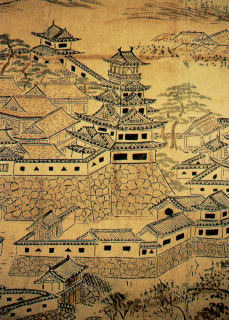 Nagoya castle
Nagoya castle
- Portuguese influences caused great turmoil in Japanese religion and economy in the 1500s. Sakai, a port city near Osaka, rose in prominence and became known for its love of tea ceremony. Takeno-Joo, who was born the year that Shuko died, made the tea ceremony even more simple, elegant and direct, qualities which were greatly admired by samurai and even the people of Sakai town.
- The new samurai embraced the customs of the tea ceremony as evidenced by the practice of Oda Nobunaga. He reunited Japan in the 1570’s and rewarded his successful generals with tea utensils which had been used by previous shoguns. His successor, Toyotomi Hideyoshi, also used the tea ceremony’s growing popularity and held three grand tea ceremonies from 1582-1583.
- In 1582, Toyotomi Hideyoshi solidified his power but kept Nobunaga’s tea people . Slowly, he gave control over his household affairs to Sen-no- Rikyu, a student of Takeno Jo-o. Rikyu made many modifications to the tea ceremony together with his master and then by himself, starting the evolution of what the traditional tea ceremony would later on be.
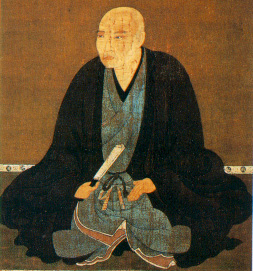
Sen-no Rikyu
- Rikyu was the one to start the use of many bamboo objects in the tea room. He was the inventor of the raku or ceramic unglazed tea bowl; he made the Fukusa smaller in size; he was the one who designed the first six-foot-square tea room with Jo-o; and also designed new and different shapes for tea objects like the mizusashi and the furo made from wood for use outdoors.
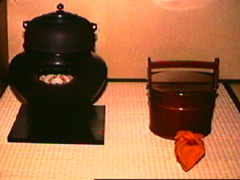
Mizusashi (hand-bucket) and chaki tied with fukusa (invented by Rikyu)
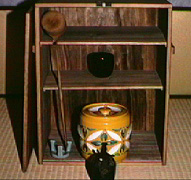
Tabidansu (portable tea cabinet) designed by Rikyu
- Rikyu is also credited with developing the principle of wabi which means a willingness to embrace simplicity rather than pomp and flamboyance and sabi which means rustic appeal of the old and imperfect. While Hideyoshi openly admitted to his wealth and power – even designing a tea room covered with gold leaves for his personal use -he still appreciated Rikyu’s principles of wabi and sabi.
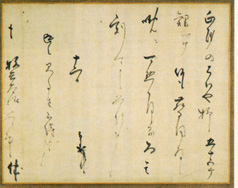
Letter from Rikyu
- In 1590, Rikyu’s relationship with Hideyoshi became strained, and the true account regarding their falling-out to this day are unknown . What is known, however, is that Hideyoshi sent Rikyu to his death. Rikyu took his own life in February 1591 in the ceremonial ritual of seppuku. Rikyu’s son Doan had also died so it was his son-in-law, Shoan, who received permission from the new Tokugawa shogun to keep his father-in-law’s tradition alive.
- When Rikyu died, Furuta Oribe who was his pupil, was appointed the tea master for the very first shogun of the Edo era by the name of Tokugawa Ieyusu. He put some of the flamboyance that Rikyu had denounced back into the tea ceremony but he was also forced to commit seppuku in 1615. Another pupil of Oribe known as Kobori Enshu established a new style called daimyo style of serving tea which later became popular with the nobles. Both Oribe and Enshu espoused aesthetics rather than the principles of wabi and sabi that had been taught by Rikyu.
- Meanwhile, Sen Sotan who lived from 1578-1658 and was the son of Shoan and grandson of Sen no Rikyu, worked at re-establishing the tea ceremony under the wabi way. He lived a simple and frugal life, refused to have any affiliations with any lord and taught students in the art of tea. He slowly became quite famous in Japan. Even though the nobles still preferred the pomp of the daimyo discipline, Sotan worked to ensure that his grandfather’s principles were never forgotten. To this end, he sent his three sons to work as a tea master to separate daimyos.
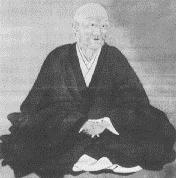 Sen Sotan
Sen Sotan
- Upon Sotan’s death, his wealth was divided between his three sons who put up the three main branches of the « house of Sen » school of tea namely : Omotesenke, Urasenke, and Mushanokoji- senke. Until the present time, direct descendants of Sotan’s sons continue to be the schools’ tea masters . Each has made small changes in the practice of tea but they all are faithful in the ways and ideas of Rikyu.
II. History of the Japanese Tea Ceremony
III. Types of the Japanese Tea Ceremony
IV. Preparing tea
V. Equipment used during a tea ceremony (temae)
VI. Tea Ceremony Equipment for Guests
VII. Rank of Tea Ceremony Utensils
VIII. Room Preparation for tea ceremony